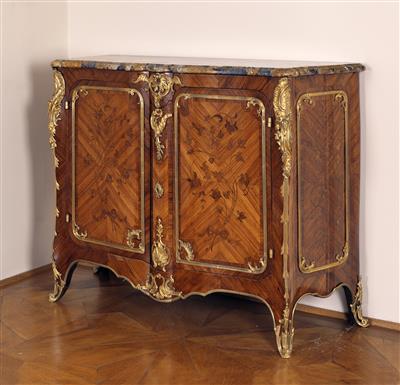A French sideboard,

modified Louis XV style from the 19th century after a model of the master cabinet-maker Charles Cressent (1685 – 1768), hardwood frame angled and curved on all sides, on curved feet, rosewood veneer, panels with crossbanded tulipwood marquetry in floral patters, outlined with bronze doré mounts, moulded marble top, 2 doors, 1 shelf, c. 105 x 136 x 52 cm, on the reverse inventory label “Mrs. Gulbenkian”, well-kept condition
The Gulbenkian family lineage may be traced back to the 4th century; the Byzantine title of nobility was acquired by members of this family in the 11th century. Later, they gained the title of Beg or Bey. It is likely that the Gulbenkian family arrived from Persia in 1725, following the end of the unstable conditions of the Ottoman-Persian Wars. After the Crimean War (1853 – 1856), the family moved to Smyrna (today, Izmir), and later to Constantinople (Istanbul). From the 19th century onwards, it is the wealthy British engineer, oil explorer, businessman, and art collector, Calouste Sarkis Gulbenkian (1869-1955), who really stands out. He is regarded as a pioneer of oil exploration in the Middle East, and is known for being the founder of the Fundaçâo Calouste Gulbenkian in Lisbon – in 1969, the foundation opened the Museu Calouste Gulbenkian, and administers the museum to this day. ASB
Esperto: Alexander Doczy
 Alexander Doczy
Alexander Doczy
+43-1-515 60-302
alexander.doczy@dorotheum.at
10.05.2017 - 17:00
- Stima:
-
EUR 18.000,- a EUR 22.000,-
A French sideboard,
modified Louis XV style from the 19th century after a model of the master cabinet-maker Charles Cressent (1685 – 1768), hardwood frame angled and curved on all sides, on curved feet, rosewood veneer, panels with crossbanded tulipwood marquetry in floral patters, outlined with bronze doré mounts, moulded marble top, 2 doors, 1 shelf, c. 105 x 136 x 52 cm, on the reverse inventory label “Mrs. Gulbenkian”, well-kept condition
The Gulbenkian family lineage may be traced back to the 4th century; the Byzantine title of nobility was acquired by members of this family in the 11th century. Later, they gained the title of Beg or Bey. It is likely that the Gulbenkian family arrived from Persia in 1725, following the end of the unstable conditions of the Ottoman-Persian Wars. After the Crimean War (1853 – 1856), the family moved to Smyrna (today, Izmir), and later to Constantinople (Istanbul). From the 19th century onwards, it is the wealthy British engineer, oil explorer, businessman, and art collector, Calouste Sarkis Gulbenkian (1869-1955), who really stands out. He is regarded as a pioneer of oil exploration in the Middle East, and is known for being the founder of the Fundaçâo Calouste Gulbenkian in Lisbon – in 1969, the foundation opened the Museu Calouste Gulbenkian, and administers the museum to this day. ASB
Esperto: Alexander Doczy
 Alexander Doczy
Alexander Doczy
+43-1-515 60-302
alexander.doczy@dorotheum.at
|
Hotline dell'acquirente
lun-ven: 09.00 - 18.00
kundendienst@dorotheum.at +43 1 515 60 200 |
| Asta: | Collezione Reinhold Hofstätter |
| Tipo d'asta: | Asta in sala |
| Data: | 10.05.2017 - 17:00 |
| Luogo dell'asta: | Wien | Palais Dorotheum |
| Esposizione: | 05.05. - 10.05.2017 |
